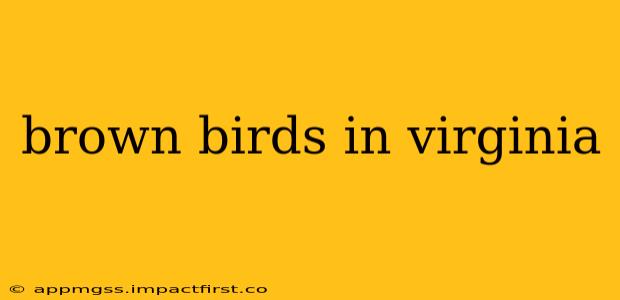Virginia boasts a rich avian diversity, and many bird species feature brown plumage, making identification sometimes challenging. This comprehensive guide will help you identify some of the most common brown birds found in the Commonwealth, covering various species, habitats, and key distinguishing features. Whether you're a seasoned birder or just starting your birdwatching journey, this guide will enhance your understanding of Virginia's feathered friends.
What are some common brown birds in Virginia?
This is a broad question, as many birds in Virginia exhibit brown as a primary or secondary plumage color. Some of the most frequently sighted brown birds include:
- Brown Thrasher: Known for its striking reddish-brown plumage, long tail, and distinctive, long, curved bill. They are often found in shrubby areas and woodlands.
- Northern Mockingbird: While not entirely brown, this bird exhibits a predominantly gray and brown plumage. Its long tail and ability to mimic other birds’ songs are key identifiers. They are adaptable and found in various habitats.
- American Robin: While robins are known for their reddish-orange breasts, their back and wings are a rich brown, especially in juvenile birds. Look for their characteristic orange breast to distinguish them.
- Eastern Towhee: These birds have a distinctive chestnut-colored back and sides, with a black cap and white belly. They are often found on the forest floor, foraging for insects and seeds.
- House Wren: A small, compact bird with a rather unassuming brown plumage. Listen for their loud, buzzing songs to help with identification.
- Field Sparrow: A small brown bird with a streaked breast and a reddish-brown cap. They prefer open fields and grasslands.
- Song Sparrow: This small sparrow is known for its distinctive streaked breast and brown coloring. Its melodic song helps with identification.
What kind of brown bird has a long tail?
Several brown birds in Virginia possess long tails. The Brown Thrasher is perhaps the most notable example, with its exceptionally long, graduated tail. The Northern Mockingbird also has a noticeably long tail, contributing to its overall striking appearance. The length of the tail, combined with other plumage characteristics and behavior, is crucial for accurate identification.
What is the smallest brown bird in Virginia?
Among the brown birds in Virginia, some of the smallest include the House Wren and various species of sparrows like the Field Sparrow and Song Sparrow. Their tiny size, combined with their brown coloration and specific markings, is important for distinguishing them from larger brown birds.
What brown bird is found near water?
While many brown birds are not exclusively tied to water sources, some are frequently found near riparian habitats. This could include certain species of sparrows that frequent the edges of marshes or streams. Specific identification depends on observing other characteristics like plumage pattern, size, and behavior. Consider checking field guides for birds commonly found in wetland areas of Virginia.
How can I identify brown birds in Virginia?
Accurate bird identification requires a multifaceted approach. Focusing solely on color is insufficient. To identify brown birds in Virginia successfully, consider these factors:
- Size and shape: Compare the bird's size to familiar objects (e.g., a robin, a sparrow). Note its overall body shape (slender, stout, etc.).
- Plumage details: Beyond overall color, look for subtle markings like streaks, spots, or patches of different colors or shades of brown. Pay attention to the color of the wings, tail, breast, and head.
- Habitat: Where did you observe the bird? Different species prefer specific habitats (e.g., forests, fields, wetlands).
- Behavior: How did the bird move? Did it hop, fly, or forage in a particular manner? Did it sing? Listening to its song can be incredibly helpful for identification.
- Field guides and apps: Utilize bird identification apps or field guides specific to Virginia.
By carefully observing these characteristics and employing resources like field guides and online databases, you can improve your chances of accurately identifying the brown birds you encounter in Virginia. Remember that practice makes perfect! Happy birding!
